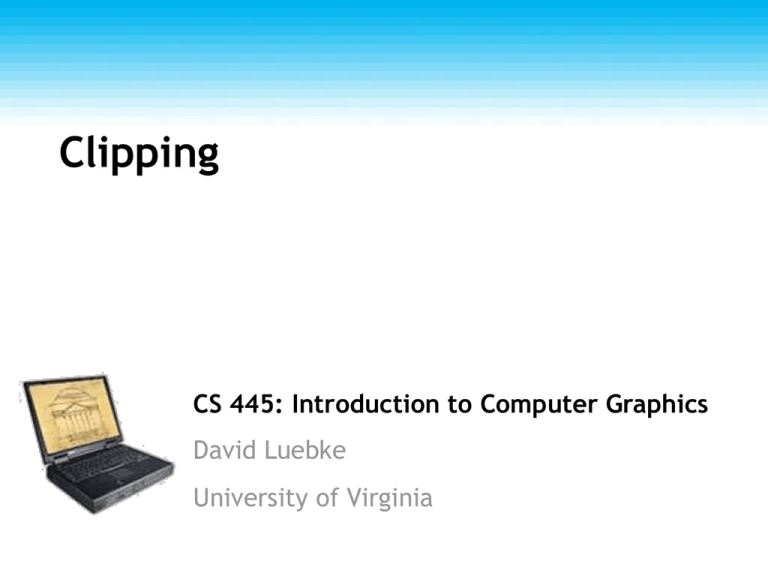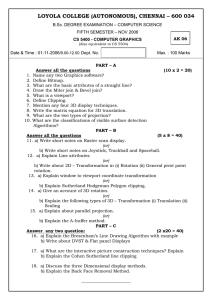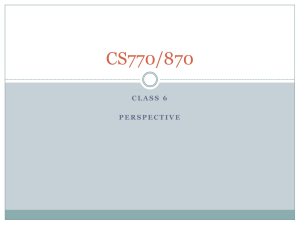Clipping CS 445: Introduction to Computer Graphics David Luebke University of Virginia
advertisement

Clipping CS 445: Introduction to Computer Graphics David Luebke University of Virginia Admin Call roll Demo Animusic Recap: Homogeneous Coords Intuitively: – The w coordinate of a homogeneous point is typically 1 – Decreasing w makes the point “bigger”, meaning further from the origin – Homogeneous points with w = 0 are thus “points at infinity”, meaning infinitely far away in some direction. (What direction?) – To help illustrate this, imagine subtracting two homogeneous points: the result is (as expected) a vector Recap: Perspective Projection When we do 3-D graphics, we think of the screen as a 2-D window onto the 3-D world: How tall should this bunny be? Recap: Perspective Projection The geometry of the situation: View plane X x’ = ? (0,0,0) Desired result: P (x, y, z) Z d dx x x' , z z d dy y y' , zd z z d Recap: Simple Perspective Projection Matrix Example: x 1 y 0 z 0 z d 0 0 1 0 0 0 1 0 1d 0 x 0 y 0 z 0 1 Or, in 3-D coordinates: x , z d y , d zd Recap: OpenGL Perspective Projection Matrix OpenGL’s gluPerspective() command generates a slightly more complicated matrix: f aspect 0 0 0 where 0 0 f 0 Ζ far Z near Z Z far near 1 0 0 0 0 2 Z far Z near Z Z near far 0 fov y f cot 2 – Can you figure out what this matrix does? Projection Matrices Now that we can express perspective foreshortening as a matrix, we can composite it onto our other matrices with the usual matrix multiplication End result: can create a single matrix encapsulating modeling, viewing, and projection transforms – Though you will recall that in practice OpenGL separates the modelview from projection matrix (why?) Next Topic: Clipping We’ve been assuming that all primitives (lines, triangles, polygons) lie entirely within the viewport In general, this assumption will not hold: Clipping Analytically calculating the portions of primitives within the viewport Why Clip? Bad idea to rasterize outside of framebuffer bounds Also, don’t waste time scan converting pixels outside window Clipping The naïve approach to clipping lines: for each line segment for each edge of viewport find intersection points pick “nearest” point if anything is left, draw it What do we mean by “nearest”? How can we optimize this? Trivial Accepts Big optimization: trivial accept/rejects How can we quickly determine whether a line segment is entirely inside the viewport? A: test both endpoints. xmin ymax ymin xmax Trivial Rejects How can we know a line is outside viewport? A: if both endpoints on wrong side of same edge, can trivially reject line xmin ymax ymin xmax Cohen-Sutherland Line Clipping Divide viewplane into regions defined by viewport edges Assign each region a 4-bit outcode: xmin 1001 xmax 1000 1010 0000 0010 0100 0110 ymax 0001 ymin 0101 Cohen-Sutherland Line Clipping To what do we assign outcodes? How do we set the bits in the outcode? How do you suppose we use them? xmin 1001 xmax 1000 1010 0000 0010 0100 0110 ymax 0001 ymin 0101 Cohen-Sutherland Line Clipping Set bits with simple tests x > xmax y < ymin etc. Assign an outcode to each vertex of line – If both outcodes = 0, trivial accept – bitwise AND vertex outcodes together – If result 0, trivial reject Cohen-Sutherland Line Clipping If line cannot be trivially accepted or rejected, subdivide so that one or both segments can be discarded Pick an edge that the line crosses (how?) Intersect line with edge (how?) Discard portion on wrong side of edge and assign outcode to new vertex Apply trivial accept/reject tests; repeat if necessary – Q: How did the programmer get stuck in the shower? – A: Lather, Rinse, Repeat Cohen-Sutherland Line Clipping Outcode tests and line-edge intersects are quite fast (how fast?) But some lines require multiple iterations: – Clip top – Clip left – Clip bottom – Clip right Fundamentally more efficient algorithms: – Cyrus-Beck uses parametric lines – Liang-Barsky optimizes this for upright volumes Coming Up… We know how to clip a single line segment – How about a polygon in 2D? – How about in 3D? Clipping Polygons Clipping polygons is more complex than clipping the individual lines – Input: polygon – Output: polygon, or nothing When can we trivially accept/reject a polygon as opposed to the line segments that make up the polygon? Why Is Clipping Hard? What happens to a triangle during clipping? Possible outcomes: Triangletriangle Trianglequad How many sides can a clipped triangle have? Triangle5-gon Why Is Clipping Hard? A really tough case: Why Is Clipping Hard? A really tough case: concave polygonmultiple polygons Sutherland-Hodgman Clipping Basic idea: – Consider each edge of the viewport individually – Clip the polygon against the edge equation Sutherland-Hodgman Clipping Basic idea: – Consider each edge of the viewport individually – Clip the polygon against the edge equation – After doing all planes, the polygon is fully clipped Sutherland-Hodgman Clipping Basic idea: – Consider each edge of the viewport individually – Clip the polygon against the edge equation – After doing all planes, the polygon is fully clipped Sutherland-Hodgman Clipping Basic idea: – Consider each edge of the viewport individually – Clip the polygon against the edge equation – After doing all planes, the polygon is fully clipped Sutherland-Hodgman Clipping Basic idea: – Consider each edge of the viewport individually – Clip the polygon against the edge equation – After doing all planes, the polygon is fully clipped Sutherland-Hodgman Clipping Basic idea: – Consider each edge of the viewport individually – Clip the polygon against the edge equation – After doing all planes, the polygon is fully clipped Sutherland-Hodgman Clipping Basic idea: – Consider each edge of the viewport individually – Clip the polygon against the edge equation – After doing all planes, the polygon is fully clipped Sutherland-Hodgman Clipping Basic idea: – Consider each edge of the viewport individually – Clip the polygon against the edge equation – After doing all planes, the polygon is fully clipped Sutherland-Hodgman Clipping Basic idea: – Consider each edge of the viewport individually – Clip the polygon against the edge equation – After doing all planes, the polygon is fully clipped Sutherland-Hodgman Clipping: The Algorithm Basic idea: – Consider each edge of the viewport individually – Clip the polygon against the edge equation – After doing all planes, the polygon is fully clipped Will this work for non-rectangular clip regions? What would 3-D clipping involve? Sutherland-Hodgman Clipping Input/output for algorithm: – Input: list of polygon vertices in order – Output: list of clipped poygon vertices consisting of old vertices (maybe) and new vertices (maybe) Note: this is exactly what we expect from the clipping operation against each edge Sutherland-Hodgman Clipping Sutherland-Hodgman basic routine: – Go around polygon one vertex at a time – Current vertex has position p – Previous vertex had position s, and it has been added to the output if appropriate Sutherland-Hodgman Clipping Edge from s to p takes one of four cases: (Purple line can be a line or a plane) inside outside inside outside inside outside p s p p output s i output p inside p s no output i output p output outside s Sutherland-Hodgman Clipping Four cases: – s inside plane and p inside plane Add p to output Note: s has already been added – s inside plane and p outside plane Find intersection point i Add i to output – s outside plane and p outside plane Add nothing – s outside plane and p inside plane Find intersection point i Add i to output, followed by p Point-to-Plane test A very general test to determine if a point p is “inside” a plane P, defined by q and n: (p - q) • n < 0: (p - q) • n = 0: (p - q) • n > 0: p inside P p on P p outside P q q q n p n n p p P P P Point-to-Plane Test Dot product is relatively expensive – 3 multiplies – 5 additions – 1 comparison (to 0, in this case) Think about how you might optimize or special-case this Finding Line-Plane Intersections Use parametric definition of edge: E(t) = s + t(p - s) – If t = 0 then E(t) = s – If t = 1 then E(t) = p – Otherwise, E(t) is part way from s to p Finding Line-Plane Intersections Edge intersects plane P where E(t) is on P – q is a point on P – n is normal to P (E(t) - q) • n = 0 t = [(q - s) • n] / [(p - s) • n] – The intersection point i = E(t) for this value of t Line-Plane Intersections Note that the length of n doesn’t affect result: t = [(q - s) • n] / [(p - s) • n] Again, lots of opportunity for optimization 3-D Clipping Before actually drawing on the screen, we have to clip (Why?) Can we transform to screen coordinates first, then clip in 2D? – Correctness: shouldn’t draw objects behind viewer (what will an object with negative z coordinates do in our perspective matrix?) (draw it…)

